When Do Australian Shepherds Go Into Heat?
Australian Shepherds are a popular and versatile breed, known for their intelligence, agility, and herding abilities. One important aspect of caring for your Australian Shepherd is understanding their heat cycle, as it is an essential part of their overall health and well-being.
The age at which Australian Shepherds go into heat can vary, but generally, it occurs for the first time between 6 and 18 months of age. It is important to note that some dogs may experience their first heat cycle earlier or later than this range, depending on individual factors. Female dogs, including Australian Shepherds, typically go into heat about twice a year, and each heat cycle can last between two to four weeks.
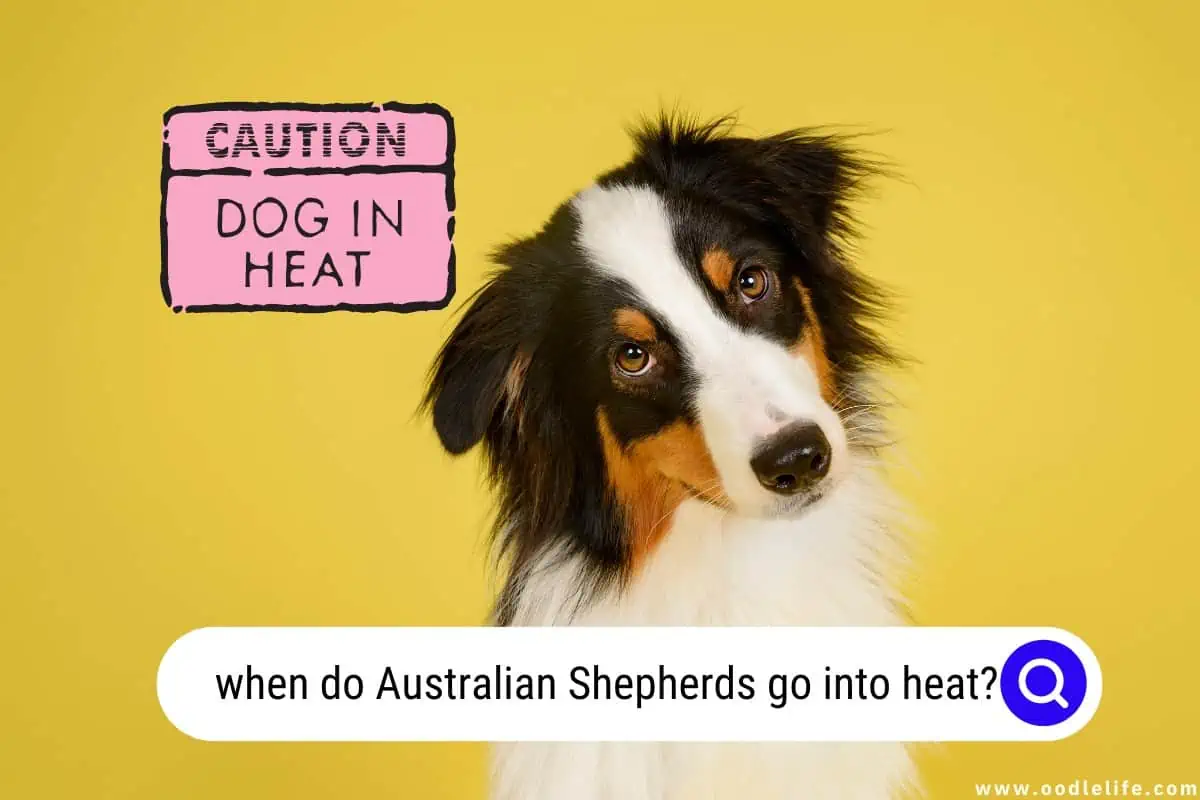
Being aware of the signs that your Australian Shepherd is in heat and knowing how to care for them during this time can help ensure their health and comfort.
Key Takeaways
- Australian Shepherds typically experience their first heat cycle between 6 and 18 months of age.
- The heat cycle generally occurs twice a year and can last from two to four weeks.
- Recognizing the signs of heat and providing appropriate care are crucial for your Australian Shepherd’s overall health and well-being.
Understanding the Heat Cycle
Australian Shepherds, like other dog breeds, go through a heat cycle, which consists of various stages. This section will provide a brief overview of the stages of the heat cycle, as well as the frequency and duration of the heat cycles in these energetic pups! 🐶
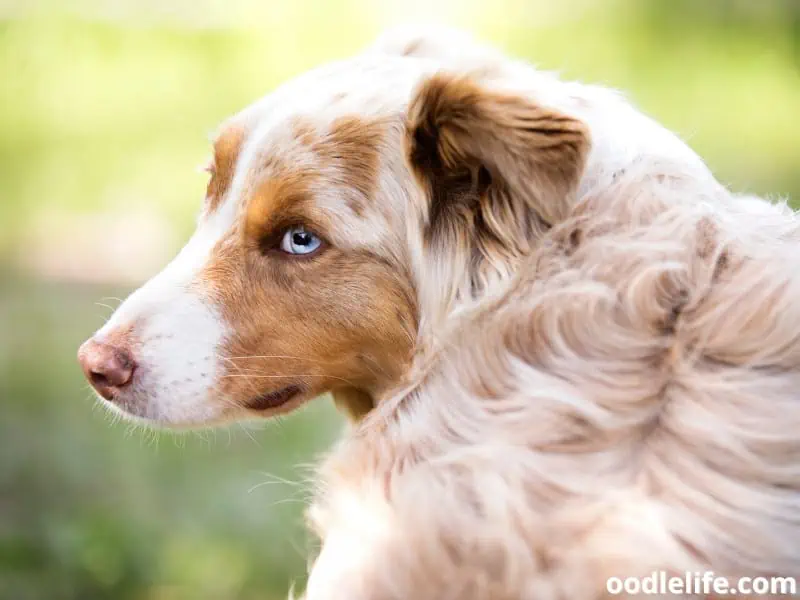
Stages of the Heat Cycle
Before we dive into the heat cycle’s specifics, it’s worth noting that it has four main stages: proestrus, estrus, diestrus, and anestrus.
Proestrus: This is the beginning stage where you’ll notice some physical changes in your furry friend, such as swelling of the vulva and a bloody discharge. Don’t worry; she’s not hurt! This stage usually lasts for 7-10 days. Your Aussie may become more affectionate or moody due to hormonal changes.
Estrus Stage: In this stage, the female Australian Shepherd becomes receptive to the attention of male dogs, and breeding can occur. The discharge may change to a lighter color, and the vulva remains swollen. This stage typically lasts around 5-9 days but can vary.
Diestrus Stage: Whether or not breeding occurred, your Aussie enters the diestrus stage. Hormone levels start to decrease, and the vulva returns to its normal size. If she is pregnant, this stage will last throughout the pregnancy (approximately 60 days). If not, diestrus usually lasts around 6-10 weeks.
Anestrus Stage: This is the “rest” stage of the heat cycle where your Australian Shepherd’s body returns to normal, and no hormonal, physical, or behavioral changes are seen. This stage typically lasts three to four months before the entire heat cycle restarts.
Frequency and Duration of Heat Cycles
Now that we’ve covered the stages, let’s discuss how often these cycles occur. Each dog is unique, but on average, Australian Shepherds experience their heat cycle every six months. Some may see it as infrequently as once a year, while others may have shorter intervals between cycles.
The total duration of the heat cycle, including all four stages, can vary but generally lasts between five and six months. Keep in mind that because each Aussie is an individual, regular check-ups with your vet are essential to ensure your dog’s reproductive health is in tip-top shape!
Signs of Australian Shepherds in Heat
When it comes to Australian Shepherds going into heat, there are a few key things to keep an eye out for. This includes physical symptoms and behavioral changes that signal your female Aussie is in her heat cycle.

Physical Symptoms
One of the most telltale signs of a female Aussie going into heat is a swollen vulva, which tends to be quite noticeable. It may grow to twice its normal size and become a darker red color. Alongside this, the dog will likely bleed to some extent, although it tends to be light at first and may become heavier during the first few days.
Owners may also observe a clear-to-pinkish discharge after the bleeding phase subsides. To handle the discharge and bleeding issues, consider using doggy diapers or special dog underwear designed for dogs in heat.
It’s also essential to keep an eye on your Aussie’s personal hygiene during this time. The furry buddy may excessively lick her vulva area to keep it clean, which is normal, but you may need to help with additional gentle cleaning.
Behavioral Changes
Aside from the obvious physical signs mentioned above, Australian Shepherds in heat may also go through hormonal changes that affect their behavior. Some female Aussies may become more affectionate, clingy, or anxious, craving more attention than usual. On the other hand, some may become more irritable or snappy during this time.
Just like humans, dogs have their unique ways of handling hormonal fluctuations.
Your usually well-behaved female Aussie may suddenly take a keen interest in male dogs, which shouldn’t be too surprising given the circumstances. A light-hearted anecdote: some affectionate Aussies in heat have been known to flirt with males by raising their rear ends in the air and wiggling them like they’re doing the doggy version of a salsa dance.
It’s important to keep an eye on these signs to ensure your Australian Shepherd gets the care she needs during her heat cycle. As a responsible pet owner, it’s essential to be prepared and stay informed for the sake of your beloved four-legged pal. So, don’t be too alarmed when your female Aussie shocks you with her sudden interest in romance – it’s all mother nature’s way of perpetuating the cycle of life!
Caring for Your Australian Shepherd During Heat
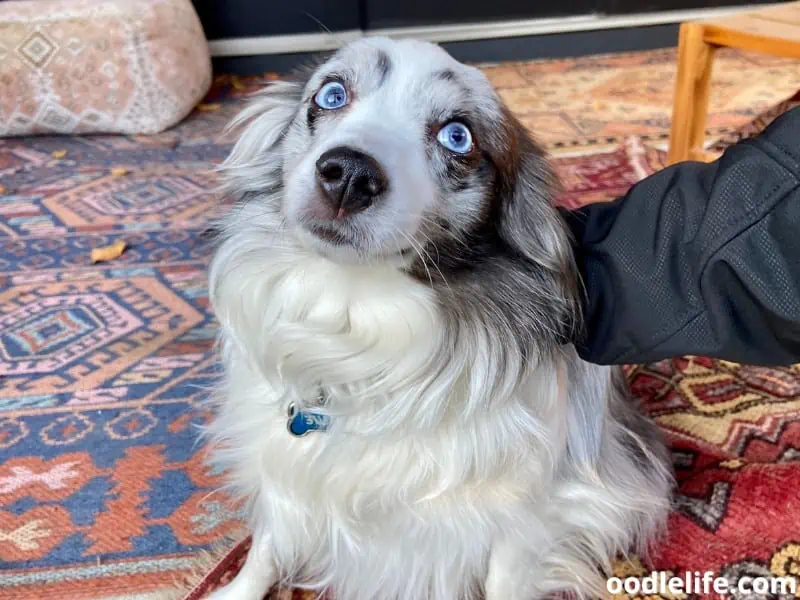
Hygiene and Comfort
During your Aussie’s heat cycle, hygiene and comfort are essential for a relaxed and content pup. To prevent unwanted messes, use hygiene pants or a diaper specifically designed for dogs. Don’t forget to change them regularly and clean their genital area to avoid infection.
Your Australian Shepherd might be more nervous and experience mood swings during heat, so be patient and understanding. Make sure their bed is cozy and surrounded by familiar items like their favorite toys and blankets. Your pup may appreciate some extra fluffy towels for additional cushioning as well.
A key tip for helping your dog stay comfortable is making sure they have access to fresh water at all times. This will help maintain their hydration, especially if increased urination occurs during the heat cycle.
Managing Male Attention
Keeping your Aussie away from potential suitors during heat is a vital responsibility of a loving owner. Going for a walk? Consider using a tail band that attracts less attention from male dogs.
If that doesn’t work, throw on a bright shirt that reads “I may be hot, but I’m not available!”
The best strategy may be avoiding places where male dogs are more likely to congregate, like popular dog parks or boarding facilities. Remember, you and your Aussie are a team – it’s up to both of you to give those handsome heartbreakers the cold shoulder.
Exercise and Mental Stimulation
It’s crucial to maintain a healthy activity level for your Australian Shepherd during heat. They still need exercise and mental stimulation, but some adjustments might be necessary. For instance, try low-impact activities like swimming or puzzle toys that challenge their cognitive abilities.
If their mood swings make your Aussie less enthusiastic about physical activities, get creative and offer more diverse games. Engage them in scent work, food puzzles, or build an indoor obstacle course from furniture and your never-ending supply of laundry. You know what they say – a busy Australian Shepherd is a happy Australian Shepherd.
Remember to keep it short and sweet, and let your pup’s energy levels guide you – after all, hard work deserves a good nap!
Age and Breed Factors
When Do Australian Shepherds First Go Into Heat?
Australian Shepherds, affectionately known as “Aussies,” are a vibrant and energetic breed. Female Aussies usually experience their first heat cycle between 6 and 9 months of age. However, this can vary depending on individual dogs and factors such as nutrition and overall health.
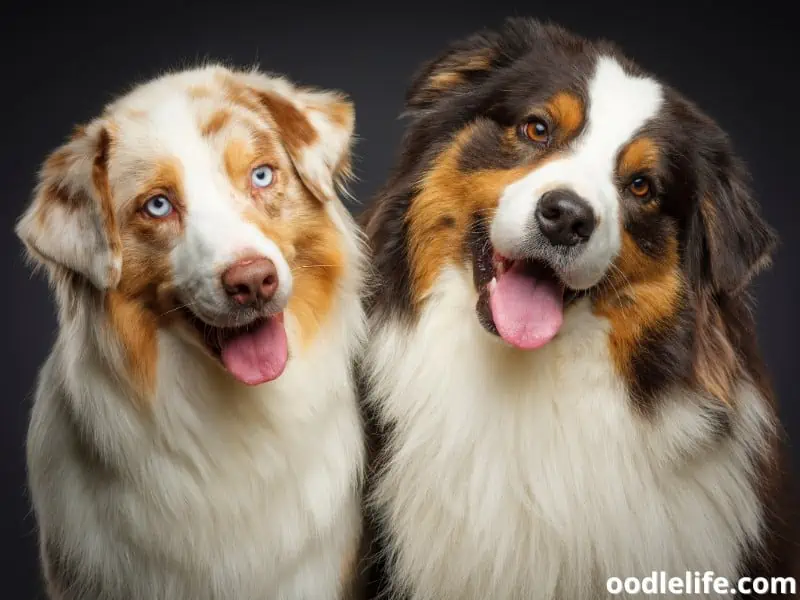
The age range for the first heat cycle is typically wider than 9 months, so don’t be alarmed if your fur baby takes a little longer to hit this milestone. Aussies are much like humans in that way – there are always early-birds and late bloomers!
Fun fact: Did you know that Australian Shepherds aren’t actually from Australia? They were developed in the United States, and their name is a nod to their herding skills and the sheep they worked with, which were originally from Australia. Talk about a confusing heritage!
Differences Between Miniature and Standard Australian Shepherds
While both Mini and Standard Australian Shepherds belong to the same breed, there are some differences in factors such as size, weight, and often, maturity. Mini Aussies typically reach physical maturity earlier than their Standard counterparts, so it’s possible that they may experience their first heat cycle at a slightly younger age.
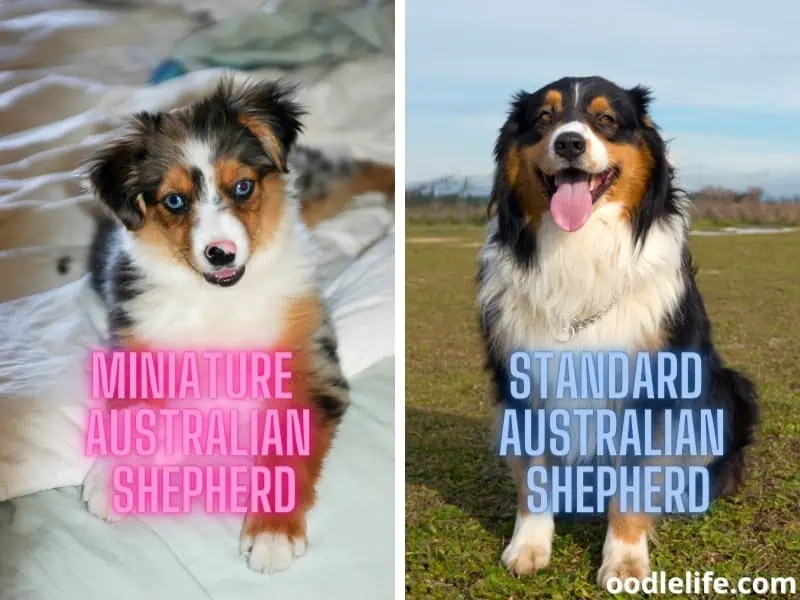
Meeting an adult Mini Aussie for the first time can be a bit disconcerting if you’ve only ever known Standard Aussies – it’s like seeing your favorite childhood teddy bear come to life in a smaller, more compact form!
Keep in mind that regardless of their size, all female Australian Shepherds go through heat cycles. The overall health, nutrition, and environment play a role in when they first go into heat. As a responsible fur parent, your goal should be to keep a close eye on your Aussie, ensuring a healthy lifestyle and proper medical support when needed.
So, whether you have a pint-sized Mini or a full-sized Standard Aussie, experiencing their first heat cycle is a natural and essential part of their lives. Think of it as just another rite of passage in the fascinating, chaos-filled adventure of sharing your life with an Australian Shepherd!
Potential Health Issues and Pregnancy Concerns
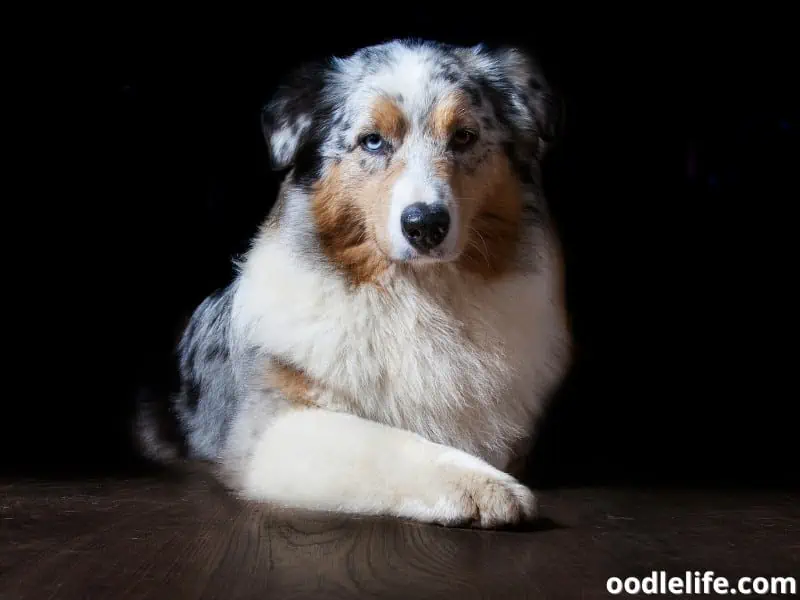
Spaying Your Australian Shepherd
Spaying your Aussie can help prevent health issues related to heat cycles. For example, there’s a slightly increased risk of mammary cancer if a female dog has one heat cycle. But on the brighter side, a spayed dog won’t attract males from miles away with that irresistible scent.
Talking with your vet about the best age to spay your Australian Shepherd is important as it varies depending on several factors.
Preventing Unwanted Pregnancies
Australian Shepherds are not only very intelligent, but they’re also born romantics. When in heat, female Aussies tend to be more receptive to male dogs, which opens the door to unwanted pregnancies. To avoid this, Australia’s Next Top Puppy situation, make sure to keep a close eye on your dog and take preventive measures like separating her from male dogs during her heat cycle.
Training your Aussie to stay in a designated area at home could also help keep any amorous relationships at bay.
Monitoring Health Issues Related to Heat
Despite their name, Australian Shepherds have a wide range of temperature tolerance from sweltering heat to frigid cold. But, pregnancy could be a game-changer. Pregnant Australian Shepherds may face health risks due to elevated temperatures, which might affect their well-being.
Remember, pregnant dogs can’t just crank up the AC or sip on a cold lemonade, so keep an eye on your pet’s comfort and visit the vet if you notice any signs of distress.
In conclusion, while Australian Shepherds tend to be healthier than, say, a potato chip, they still require monitoring and care during their heat cycles. So, buckle up for some exciting doggy parenting by keeping these tips in mind.
Frequently Asked Questions
How often do they go into heat?
Australian Shepherds typically go into heat every 6 to 9 months. However, it’s important to remember that every dog is different, and some may experience heat cycles more or less frequently.
What are the heat symptoms?
During heat, you may observe your Aussie becoming more restless, showing signs of discomfort, and frequently licking her genital area. Other symptoms include mood swings, swollen vulva, and bloody discharge. Also, don’t be surprised if your usually well-behaved dog suddenly finds the neighbor’s dog utterly irresistible.
When is the ideal spaying age?
The ideal spaying age for Australian Shepherds is between 6 to 9 months, before their first heat cycle. This can help reduce the risk of certain health issues, such as breast cancer and uterine infections. However, always consult your trusted veterinarian for the best advice tailored to your furry friend’s specific needs.
At what age can they get pregnant?
Female Australian Shepherds can potentially get pregnant as early as their first heat cycle, which can occur between 6 to 9 months old. To prevent any unplanned puppies, it’s wise to keep an extra watchful eye on your young Aussie during this time.
How long is the bleeding during heat?
Bleeding during an Australian Shepherd’s heat cycle can last anywhere from 7 to 14 days, with the heaviest flow usually occurring during the first week. Pro tip: doggy diapers can be a lifesaver during this time.
When is the mellowing out age?
Australian Shepherds typically begin to mellow out around 3 to 4 years of age, as they transition from energetic teenagers to more mature adults. However, their love for adventure, play, and mental stimulation remains strong, so don’t expect a sudden couch potato!